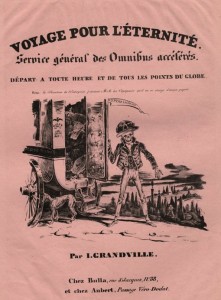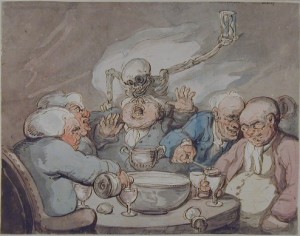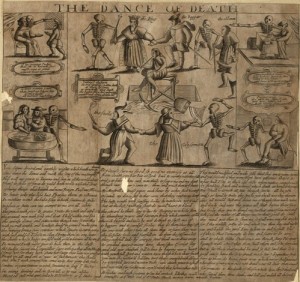We are in Dickens Year: on 7 February, we will be celebrating the 200th anniversary of his birth. A copy of Douce’s The Dance of Death bearing the bookplate of Charles Dickens can be found in the Special Collections of the University of Glasgow:
University of Glasgow Special Collections
Douce published his study of ‘the extremely popular subject of the Dance of Death’ in 1833. The popularity to which Douce referred is attested by the success of Thomas Rowlandson’s The English Dance of Death (1814-16). Douce owned several related drawings, and a watercolour of a similar subject with the ominous inscription ‘Sooner or later the luck turns’:
Douce’s The Dance of Death focuses on Hans Holbein’s series of ‘elegant emblems of human mortality’, which he had reproduced by the wood-engravers George Wilmot Bonner and John Byfield. But Douce also drew on other works from his own collection to study the representation of this theme throughout the centuries. The images to which he referred in his introductory essay are still kept together in one of Douce’s original wooden boxes, labelled N.6.
The arrangement of the prints by subjects regardless of artists, periods or schools is characteristic of Douce’s collection. An etching entitled The Dance of Death and published by Robert Walton around 1666-67:
can be found next to this album of hand-coloured lithographs by J. J. Grandville published in 1830:
 Grandville’s update of the theme of the Dance of Death was praised by Honoré de Balzac in La Silhouette and mentioned by Alexandre Dumas père in his Mémoires. In his account of the creative process from which Grandville’s plates sprung, Dumas described the results as ‘a world more fantastic than that of Callot’s Temptations and Brueghel’s Diableries’ (‘un monde plus fantastique que les tentations de Callot et les diableries de Breughel’). Douce owned examples of both.
Grandville’s update of the theme of the Dance of Death was praised by Honoré de Balzac in La Silhouette and mentioned by Alexandre Dumas père in his Mémoires. In his account of the creative process from which Grandville’s plates sprung, Dumas described the results as ‘a world more fantastic than that of Callot’s Temptations and Brueghel’s Diableries’ (‘un monde plus fantastique que les tentations de Callot et les diableries de Breughel’). Douce owned examples of both.
Dickens explicitly referred to the subject of the Dance of Death in the Pickwick Papers and in Nicholas Nickleby. His use of this theme as a metaphor evinces how his constant crossing and blurring of the boundaries between wealth and poverty, life and death, stand in a long tradition, the origins of which may be traced back to the early modern prints collected by Douce.


